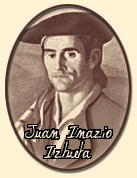 |  | The gallops are performed as follows: Each gallop consists of five beats, in other words:
1. On the first beat, with the feet in the correct place to start the dance, [the dantzari] opens both feet, the right to the right and the left to the left, with a foot span between both heels. The heels should face each other and the tips of the feet pointing outwards. 2. On the second beat, while keeping his right foot motionless, [the dantzari] has to position his left foot in such a way that his big toes touches his right heel. 3. On the third beat, while keeping his left foot motionless, [the dantzari] has to lift his right foot and move it a foot span to the right, while keeping the tip of his foot looking outwards.
4. On the fourth beat, while keeping his right foot motionless, he has to position his left foot in such a way that his left heel is touching the inside of the right big toe. 5. On the fifth beat, while keeping his left foot motionless, he position the right foot in such a way that his heel is touching the central part of his left instep, with the tip looking to one side, and both fee forming the shape of an acephalous cross. This is a gallop, which is performed to the right..
The gallop is likewise performed to the left, so that once the gallop to the right is completed, he just to click open both feet to their respective sides and leave a foot span between them. On the second beat, while keeping the left foot motionless, the right foot is placed in such a way that its big toe touches the left heel. On the third beat, while keeping the right foot motionless, the left foot is moved one span forwards to the left. On the fourth beat, while keeping his left foot motionless, he has to position his right foot in such a way that his heel is touching the inside of the left big toe; and on the fifth beat, while keeping his right foot motionless, the left foot is placed in such a way that the heel is touching the inner centre of the right instep. These are the single gallops. |  |


